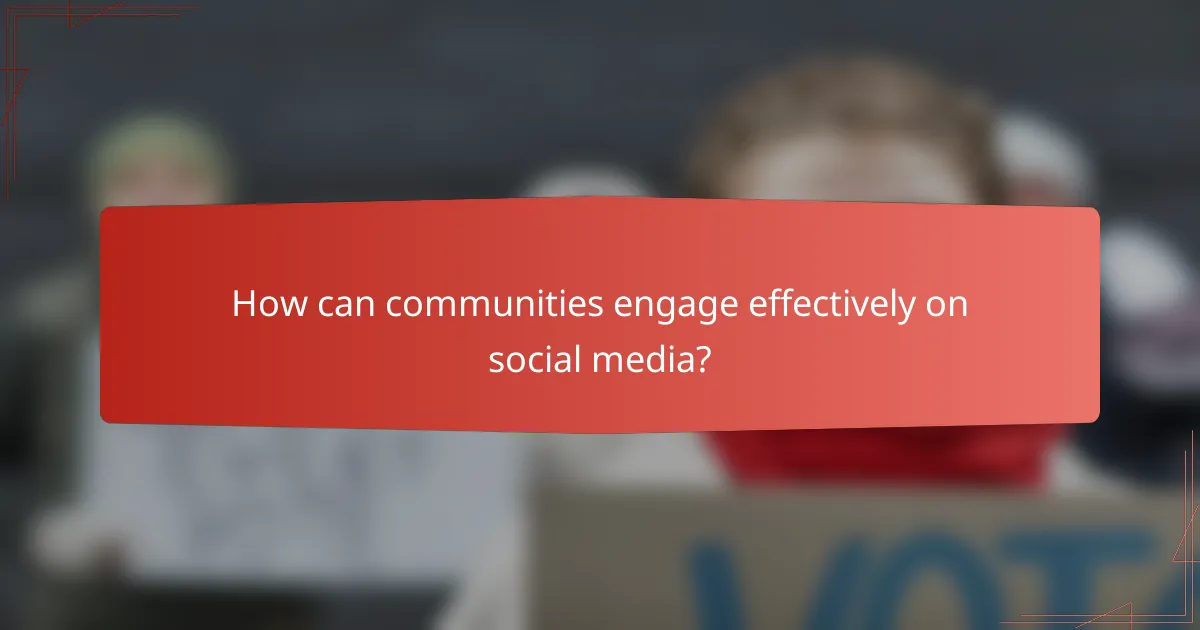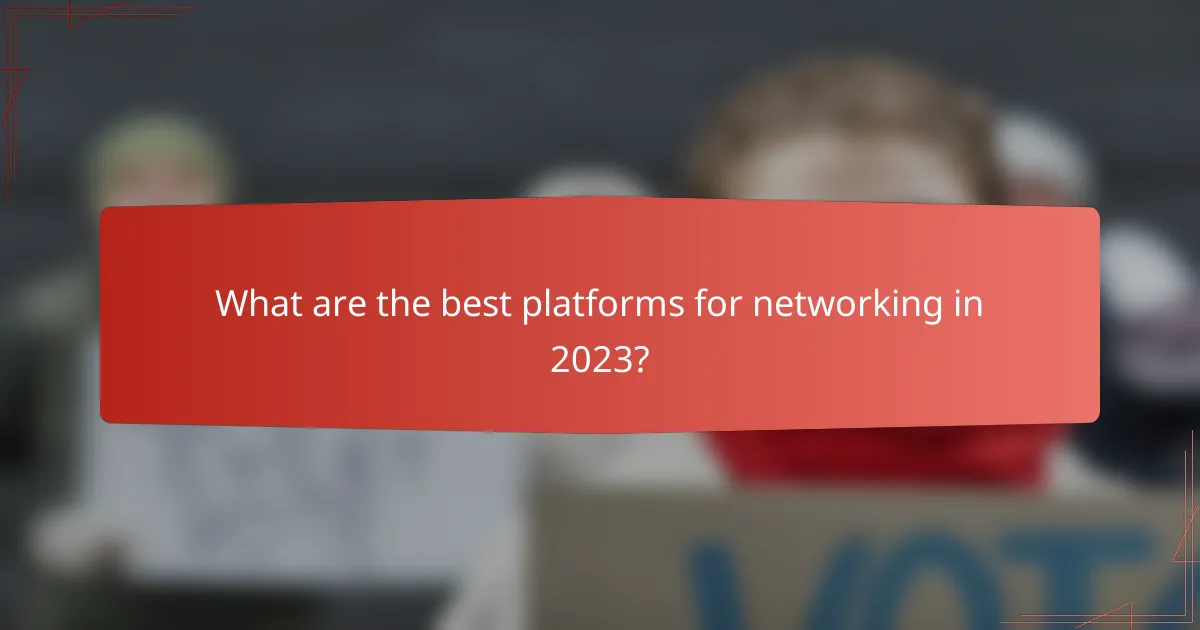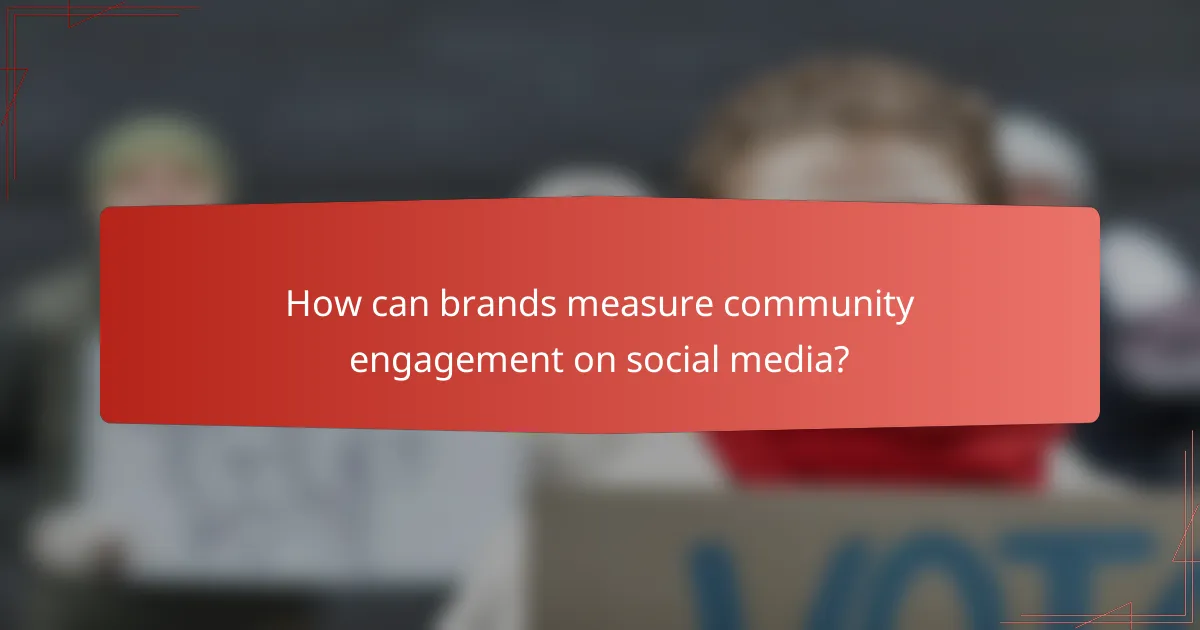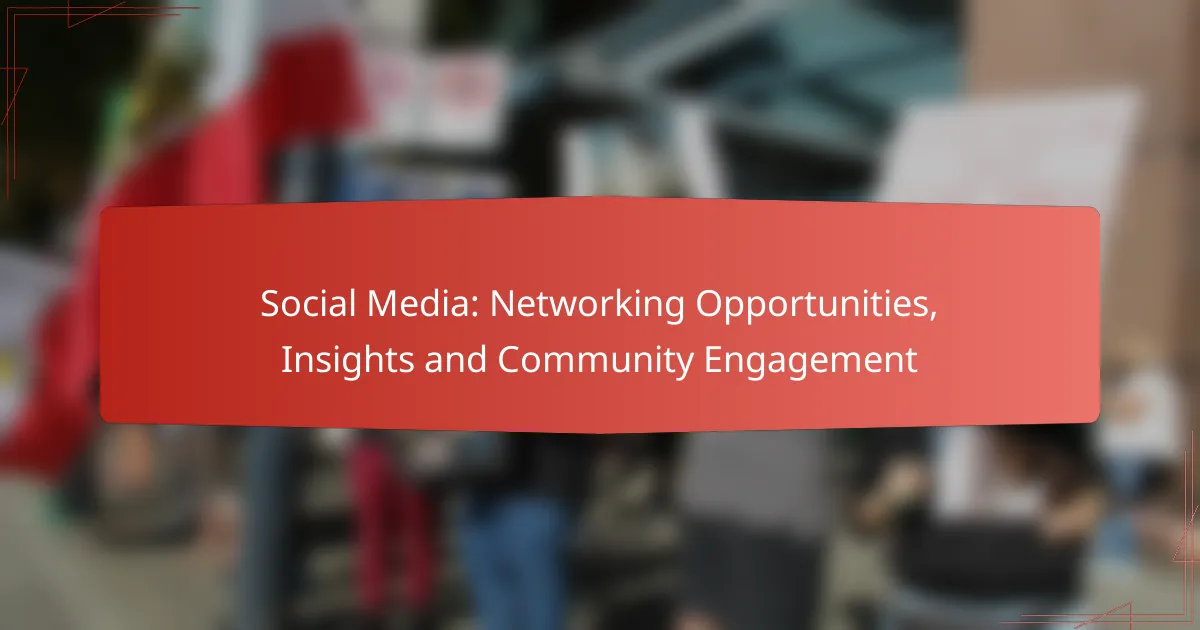Social media plays a pivotal role in enhancing networking opportunities, allowing professionals to connect and share valuable insights that can lead to career advancements and collaborations. It also provides businesses with crucial market insights, helping them understand customer preferences and improve their strategies. Additionally, social media fosters community engagement by encouraging meaningful interactions and a sense of belonging among members.

How can social media enhance networking opportunities in the US?
Social media significantly enhances networking opportunities in the US by providing platforms for professionals to connect, share insights, and build relationships. These platforms facilitate interactions that can lead to job opportunities, collaborations, and industry knowledge exchange.
Increased visibility for professionals
Social media allows professionals to showcase their skills and achievements, increasing their visibility within their industry. By sharing content related to their expertise, individuals can attract the attention of potential employers and collaborators.
Regularly updating profiles and engaging with relevant content can enhance this visibility. For example, posting articles or insights on LinkedIn can position a professional as a thought leader in their field.
Access to industry-specific groups
Many social media platforms host groups focused on specific industries or interests, providing a space for professionals to connect and share knowledge. Joining these groups can lead to valuable discussions and networking opportunities.
For instance, Facebook and LinkedIn have numerous groups where members can ask questions, share resources, and find job postings relevant to their field. Actively participating in these groups can help build a professional reputation and foster connections.
Real-time connection with influencers
Social media enables real-time interactions with industry influencers, allowing professionals to engage directly with leaders in their field. This can lead to mentorship opportunities and collaborations that may not be possible through traditional networking methods.
Following and interacting with influencers on platforms like Twitter or Instagram can provide insights into industry trends and best practices. Commenting on their posts or sharing relevant content can help establish a connection and increase visibility within the professional community.

What insights can social media provide for businesses?
Social media offers valuable insights for businesses by revealing market trends, customer preferences, and engagement levels. These insights can help companies make informed decisions, enhance their marketing strategies, and foster stronger connections with their audience.
Market trends analysis
Social media platforms are rich sources of data that can help businesses identify emerging market trends. By monitoring discussions, hashtags, and content shares, companies can gain insights into what products or services are gaining popularity. For example, a spike in conversations around sustainable products may indicate a growing consumer preference for eco-friendly options.
To effectively analyze market trends, businesses should utilize social listening tools that aggregate and analyze social media data. These tools can track sentiment, engagement rates, and demographic information, allowing companies to adapt their offerings accordingly. Regularly reviewing these insights can help businesses stay ahead of the competition.
Customer feedback and engagement metrics
Social media provides a direct channel for customer feedback, enabling businesses to gauge satisfaction and identify areas for improvement. Monitoring comments, reviews, and direct messages can reveal customer sentiments and highlight common issues. For instance, if multiple customers express dissatisfaction with a specific feature, it may warrant immediate attention.
Engagement metrics, such as likes, shares, and comments, are essential for understanding how well content resonates with the audience. Businesses should track these metrics to evaluate the effectiveness of their campaigns and adjust their strategies accordingly. A high engagement rate typically indicates that the content is relevant and appealing, while low engagement may suggest a need for a content refresh.

How can communities engage effectively on social media?
Communities can engage effectively on social media by fostering meaningful interactions and creating a sense of belonging among members. This involves utilizing various strategies that promote participation, sharing, and collaboration.
Creating interactive content
Interactive content encourages active participation from community members, making them feel more involved. Examples include polls, quizzes, and user-generated challenges that invite responses and feedback.
To maximize engagement, consider using visually appealing formats such as videos or infographics. Aim for content that resonates with your audience’s interests and encourages sharing, which can expand your reach.
Do ensure that your interactive content is easy to access and participate in. Avoid overly complex formats that may deter users from engaging.
Utilizing live events and webinars
Live events and webinars provide real-time interaction opportunities, allowing communities to connect and engage directly. These formats can include Q&A sessions, discussions with experts, or community showcases that highlight member achievements.
When planning a live event, choose a platform that suits your audience, such as Zoom or Facebook Live. Promote the event in advance to build anticipation and encourage attendance.
Do keep the sessions concise and focused, ideally lasting no longer than an hour. This helps maintain viewer interest and encourages participation without overwhelming attendees.

What are the best platforms for networking in 2023?
In 2023, the best platforms for networking include LinkedIn, Facebook, and Twitter, each serving unique purposes for professional connections, community building, and industry news. Choosing the right platform depends on your networking goals and the audience you wish to engage with.
LinkedIn for professional connections
LinkedIn is the premier platform for establishing and nurturing professional relationships. It allows users to connect with colleagues, industry leaders, and potential employers, making it essential for career advancement.
To maximize your LinkedIn networking, ensure your profile is complete and showcases your skills and experiences. Engage with content relevant to your field, join industry-specific groups, and participate in discussions to increase visibility.
Avoid sending generic connection requests; personalize your messages to improve acceptance rates. Regularly update your profile to reflect new achievements and skills.
Facebook for community building
Facebook excels in fostering community engagement through groups and events. It allows users to connect with like-minded individuals and share resources, making it ideal for building support networks.
To effectively use Facebook for networking, join groups that align with your interests and actively participate in discussions. Share valuable content and resources to establish yourself as a knowledgeable member of the community.
Be mindful of privacy settings and consider creating a professional page if you want to maintain a clear boundary between personal and professional interactions.
Twitter for industry news
Twitter is a fast-paced platform that serves as a hub for real-time industry news and updates. It allows users to follow thought leaders, engage in conversations, and stay informed about trends and developments.
To leverage Twitter for networking, follow relevant hashtags and accounts in your industry. Participate in Twitter chats and share insights to build your reputation as an informed professional.
Be concise in your communications and use visuals when possible to enhance engagement. Avoid excessive self-promotion; focus on providing value to your followers.

What criteria should businesses consider when choosing social media platforms?
Businesses should evaluate their goals, target audience, and content type when selecting social media platforms. Understanding these criteria helps in maximizing engagement and achieving marketing objectives.
Target audience demographics
Identifying the demographics of your target audience is crucial for effective social media strategy. Different platforms attract varying age groups, interests, and locations. For instance, Instagram and TikTok are popular among younger users, while Facebook has a broader age range.
Consider conducting surveys or utilizing analytics tools to gather insights about your audience’s preferences. This data allows you to choose platforms that align with where your potential customers are most active.
Content format compatibility
Each social media platform supports different content formats, which can influence your choice. For example, visual content thrives on Instagram and Pinterest, while Twitter is better suited for short text updates. Understanding these formats helps in crafting tailored content that resonates with users.
Evaluate the types of content you plan to produce—videos, images, articles, or infographics—and match them with platforms that enhance their visibility. This alignment can significantly boost engagement and reach.

How can brands measure community engagement on social media?
Brands can measure community engagement on social media by analyzing various metrics that reflect user interactions and growth. Key indicators include engagement rates, follower growth, and qualitative feedback from the audience.
Engagement rate analysis
Engagement rate analysis involves calculating the level of interaction users have with a brand’s content. This can be measured through likes, shares, comments, and saves relative to the total number of followers or impressions.
To calculate the engagement rate, divide the total interactions by the total reach or followers, then multiply by 100 to get a percentage. Generally, an engagement rate of 1-3% is considered average, while rates above 3% indicate strong community involvement.
Follower growth tracking
Follower growth tracking is essential for understanding how a brand’s audience expands over time. This metric can be monitored weekly or monthly to identify trends and spikes in interest.
Brands should consider both the quantity and quality of followers. A steady increase in followers is positive, but brands should also assess if new followers actively engage with content. Tools like social media analytics dashboards can help visualize growth patterns and inform strategy adjustments.



